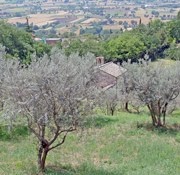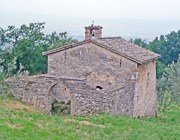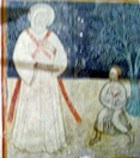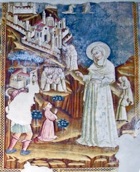


Bianchi March (1399)
This church has its origins in the Bianchi march, which began in 1399, probably in Provence, and culminated in Rome in the Jubilee celebrations of 1400. During this period, bands of penitents, known as the Bianchi, or Albati (White Penitents), went in procession from city to city, converging on Rome. They were clad in white garments, with their faces hooded and only the eyes left uncovered, and each wore a red cross on his or her back. After the marchers had satisfied their spiritual ardour in Rome, Pope Boniface IX began to worry about the threat that they posed to public order and he therefore dissolved the movement.
According to the foundation myth of the movement, Christ appeared to a farmer dressed as a pilgrim and asked for bread. The farmer said that he had none, but wen the pilgrim insisted he found three loaves that had miraculously appeared in his bag. The pilgrim told him to throw them in a nearby stream but the farmer insisted that no such stream existed. However, the pilgrim persisted and the farmer found that a stream had duly appeared. He went over to it and was about to do as he had been told when a woman appeared and begged him not to. He nevertheless threw one of the loves in the stream, at which point the distraught woman told him that she was the Virgin. Christ had ordained the destruction of mankind because of its sins and, now that one of the miraculous loaves had been thrown in the stream, a third of mankind would die. The farmer asked what he could do to save the rest and the Virgin told him to organise a penitential procession that would march from town to town, telling people about the danger.
Santa Maria dell’ Olivo

The marchers seem to have left Perugia for Assisi in 1399. According to local tradition, the Virgin appeared to a boy in an olive grove outside Porta Nuova and exhorted him to rouse the citizens to join the Bianchi march. The fresco above, which is one of many in Italy that depict the miracle, was discovered at San Francesco, Leonessa in 1993. (It is reproduced here because of the interesting cityscape of Assisi, which includes Porta Nuova). The feast of the “Madonna dell’ Oliva” was celebrated for centuries in Assisi on 2nd July, which is also the date of the Feast of the Visitation of the Virgin.
The church built on the site of this miracle, which was first documented in 1403, featured in a number of legacies in the following decades. It has been restored on a number of occasions, most recently in 1964.
A very damaged fresco (15th century) depicting the apparition survives inside the church. Similar frescoes also survive in (among other places):



